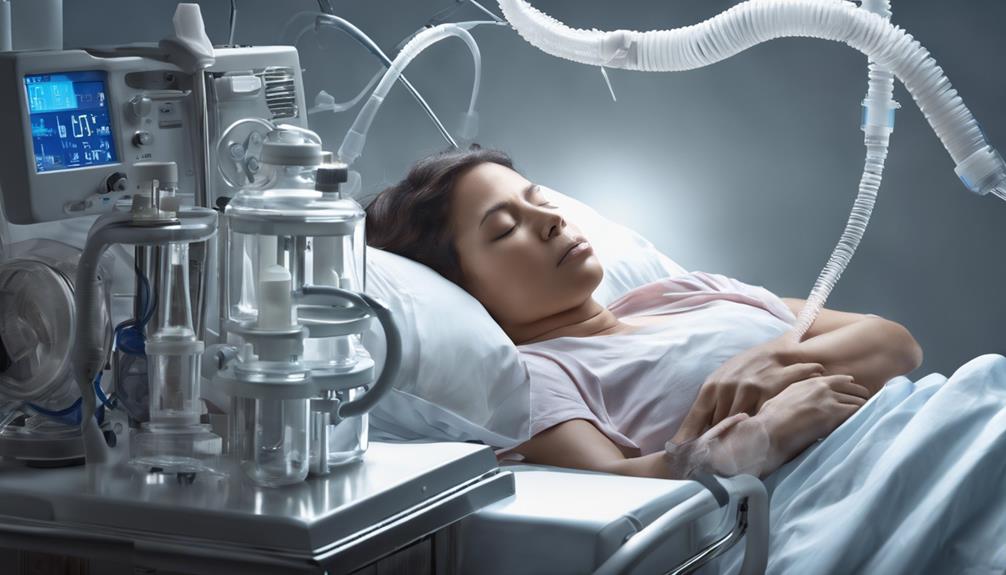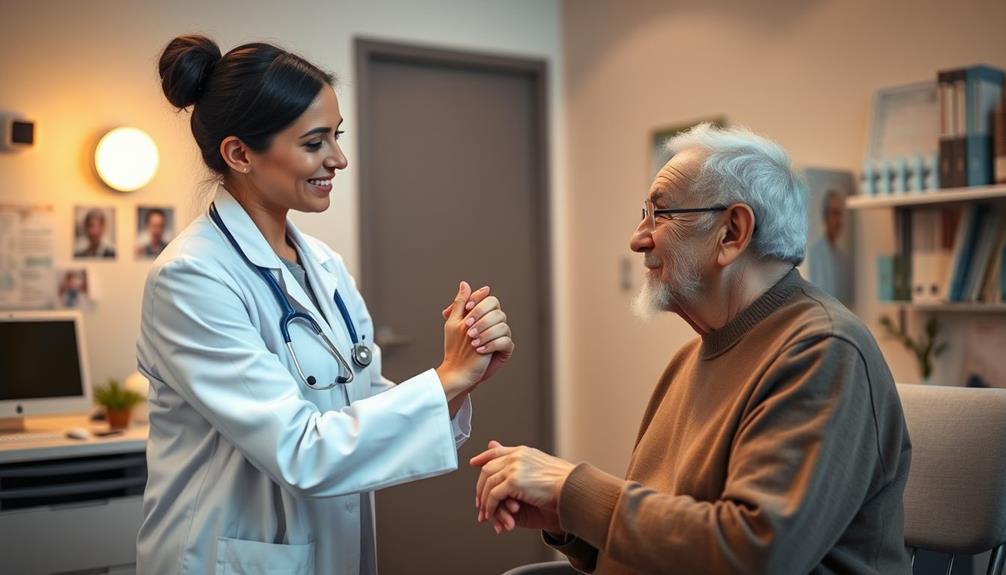Engaging in both exercise and physical therapy is essential in managing Parkinson’s disease and improving your overall quality of life. Regular physical activity can help enhance mobility, strength, and flexibility while reducing symptoms such as rigidity and balance issues. Aerobic exercises like walking or swimming, strength training, and flexibility routines are all helpful. Starting an exercise program early on is crucial as it can slow down the progression of the disease. Participating in community programs can also help boost motivation. Finding the right exercises can greatly impact daily living. If you are interested in exploring effective strategies, there is much more to learn.
Key Takeaways
- Physical therapy enhances mobility, strength, and flexibility, significantly improving the quality of life for individuals with Parkinson's disease.
- Regular exercise can delay physical decline and reduce the risk of falls through targeted balance and coordination training.
- Aerobic activities like walking and swimming are recommended for at least 150 minutes weekly to boost overall health.
- Early intervention with specialized exercises helps manage symptoms and maintain functional abilities in the initial stages of Parkinson's.
- Community exercise programs foster motivation and provide essential resources for maintaining an active lifestyle among those affected by Parkinson's.
What Is Parkinson's Disease?
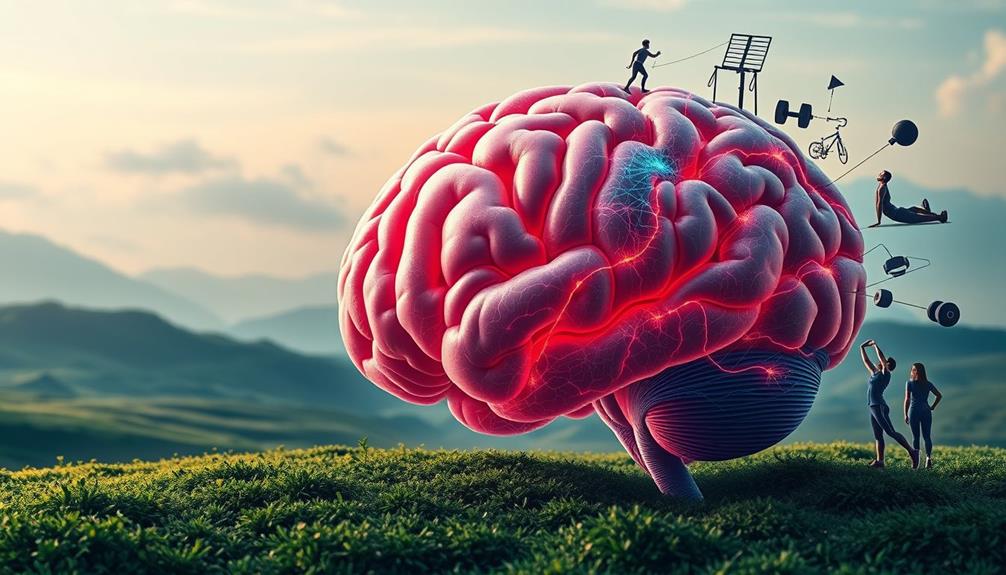
Parkinson's disease is a progressive neurological disorder that affects movement and coordination. This condition arises from the degeneration of dopamine-producing nerve cells in the brain, leading to significant challenges in daily life. Approximately 1% of individuals over the age of 60 are affected, with symptoms often starting on one side of the body.
Understanding the significance of cold medications overview can be beneficial, especially when managing symptoms like fatigue and discomfort that may accompany Parkinson's.
You might notice common motor symptoms like tremors, bradykinesia (slowness of movement), muscle rigidity, and postural instability. These symptoms can make simple tasks increasingly difficult.
It's vital to understand that non-motor symptoms, such as fatigue, depression, and sleep disturbances, can also impact your quality of life.
Diagnosing Parkinson's disease relies on your medical history and a neurological examination, as there's no definitive test available. However, if you experience significant symptom improvement with medication, it can support the diagnosis.
The global prevalence of Parkinson's disease is estimated at 6.1 million people, and this number is projected to exceed 12 million by 2050, highlighting its growing impact on public health.
Understanding Parkinson's disease is important for managing its effects and seeking appropriate treatment options. Research into Parkinson’s disease has shown that early diagnosis and a tailored approach to treatment can greatly improve quality of life. In addition to traditional medication, many patients explore alternative therapies for Parkinson’s, such as physical therapy, acupuncture, or dietary changes, to help manage symptoms. These complementary approaches can work alongside conventional treatments to address both motor and non-motor symptoms effectively.
Symptoms and Impact on Quality of Life
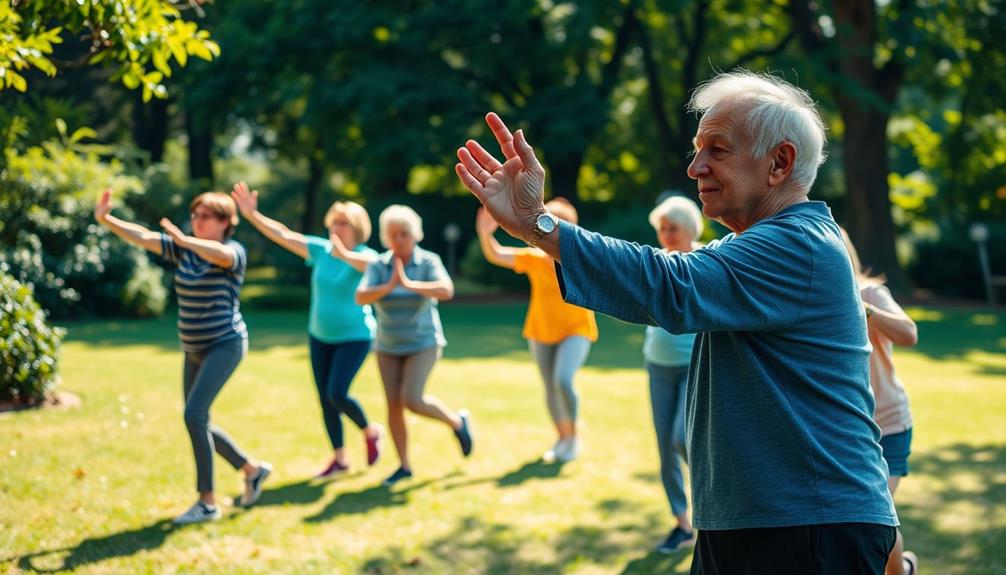
Living with Parkinson's disease means facing a range of symptoms that can greatly impact daily life. These symptoms can be divided into motor and nonmotor categories, both of which affect your quality of life.
| Type of Symptoms | Examples |
|---|---|
| Motor Symptoms | Muscle stiffness, tremors, slowed movement, balance issues |
| Nonmotor Symptoms | Fatigue, depression, anxiety, disrupted sleep |
| Impact on Mobility | Difficulty in daily activities like dressing or walking |
| Communication Challenges | Smaller movements, stooped posture, voice changes |
| Emotional Support Needs | Increased feelings of isolation and anxiety |
Motor symptoms like balance problems and slowed movement can severely affect your mobility, making daily activities difficult. Nonmotor symptoms, such as fatigue and depression, can further diminish your overall well-being. Physical therapy plays an essential role in managing these symptoms; exercises can improve motor function and enhance balance, helping you navigate your environment more easily. Additionally, emotional support is important, as social connections can combat feelings of isolation and boost mental health. By addressing both motor and nonmotor symptoms, you can greatly enhance your quality of life with Parkinson's.
Diagnosis and Evaluation Process
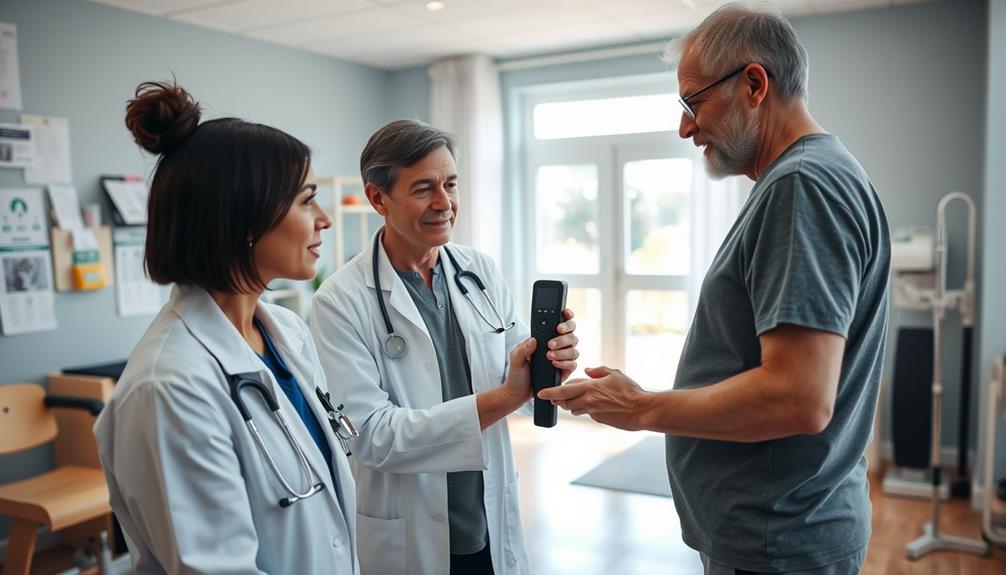
When you suspect Parkinson's disease, understanding the diagnostic criteria is essential.
Early evaluation can make a significant difference in your treatment options and quality of life.
Recognizing symptoms like intense episodes of anger can help in identifying the need for professional assessment.
Diagnostic Criteria Overview
Diagnosing Parkinson's disease (PD) involves a careful assessment of several clinical symptoms, primarily focusing on slowness of movement, resting tremors, and muscle rigidity. A neurological examination is essential for confirming the diagnosis of Parkinson's disease, as there's no definitive test available.
It's vital to highlight that nonmotor symptoms, like a decreased sense of smell and sleep disturbances, often appear before motor symptoms and can provide valuable insights during the diagnostic process. Understanding the impact of key domains of development can also be beneficial when considering how Parkinson's affects various aspects of life.
Imaging techniques, such as MRI and CT scans, help rule out other neurological conditions that may mimic PD symptoms. The diagnosis process emphasizes the need for early intervention; recognizing PD promptly can lead to a more effective treatment plan.
Tailoring an exercise program and incorporating personalized physical therapy can greatly contribute to improved quality of life for individuals with Parkinson's.
Importance of Early Evaluation
Early evaluation of Parkinson's disease is essential for ensuring the best possible outcomes. When you notice early signs, such as non-motor symptoms like a decreased sense of smell or sleep disturbances, seeking a thorough assessment becomes critical. This evaluation will include a detailed medical history and clinical tests to identify any motor symptoms, muscle tone, and coordination issues.
Understanding the importance of financial health can also play a role in managing healthcare costs associated with Parkinson's treatment.
Since there's no definitive test for Parkinson's, the diagnostic process often involves imaging techniques like MRI and CT scans to rule out other conditions. Functional neuroimaging methods, such as PET and SPECT scans, help assess dopamine levels in the brain, which is essential for an accurate diagnosis.
Timely intervention following an early evaluation can greatly improve your quality of life. By recognizing the early symptoms and starting physical therapy early, you can enhance your treatment effectiveness.
Regular monitoring during this evaluation process is important, as noticeable improvements with medication can support the diagnosis. Ultimately, early evaluation sets the stage for appropriate interventions that can lead to better management of Parkinson's disease.
Benefits of Physical Therapy

Physical therapy can make a considerable difference for individuals with Parkinson's disease, helping to enhance mobility, strength, and flexibility. By engaging in tailored exercise programs, you can effectively address both the motor and non-motor symptoms of the disease.
Regular participation in physical therapy not only improves your overall quality of life but also delays the progression of physical decline associated with Parkinson's. In addition, incorporating structured creativity exercises into your routine can further stimulate mental engagement, which is crucial for overall well-being.
Personalized therapy plans are created based on your specific needs and abilities, ensuring the exercises you perform are ideal for your situation. This individualized approach fosters a sense of control over your condition, boosting your confidence and self-esteem as you regain independence in daily activities.
Moreover, targeted exercises in physical therapy can greatly reduce fall risk by improving your balance and coordination. Studies have shown a 25% reduction in falls among those who consistently engage in regular exercise.
Recommended Exercise Types

Engaging in a variety of exercise types is fundamental for managing Parkinson's disease effectively. To enhance your mobility and overall health, incorporate aerobic exercises like walking, cycling, or swimming for at least 150 minutes each week. These activities improve cardiovascular health and help maintain your stamina.
Additionally, maintaining hydration and considering a balanced diet rich in antioxidants, such as cranberry juice consumption, can further support your overall health during exercise.
Strength training is equally important. Resistance exercises, such as leg presses and squats, increase muscle strength and stability, counteracting muscle rigidity and boosting your daily functional abilities.
Don't forget about flexibility exercises; routine stretching for major muscle groups is essential for maintaining joint range of motion and reducing stiffness.
Balance exercises, including tai chi and yoga, notably lower your fall risk by improving stability and coordination. These should be critical components of your exercise regimen.
Additionally, consider participating in dance programs specifically designed for individuals with Parkinson's. These programs promote coordination, rhythm, and social engagement, enhancing both your physical and emotional well-being.
Importance of Early Intervention
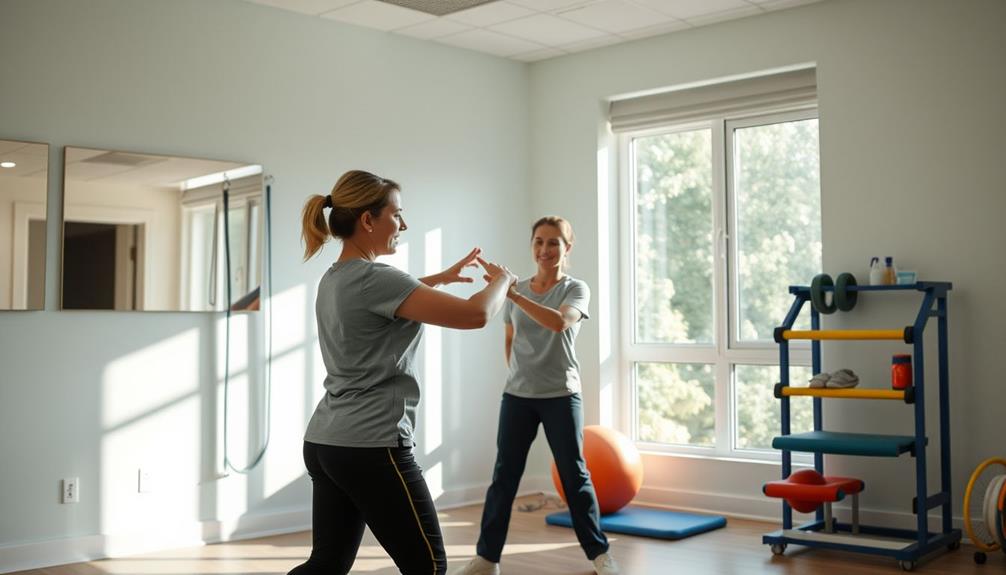
Recognizing the importance of timely action can make a significant difference in managing Parkinson's disease. Early intervention is essential, as it can greatly enhance treatment effectiveness, helping you improve mobility and overall quality of life.
Engaging in specialized exercises during the initial stages allows you to address unique challenges and slow the physical decline associated with Parkinson's. Incorporating gentle stretching and balance exercises can further enhance your routine and reduce discomfort, similar to yoga for back pain.
Research shows that starting a consistent exercise regimen early reduces motor symptoms and improves daily living activities. When you participate in early physical therapy, you're likely to experience better outcomes in balance, strength, and functional mobility compared to those who wait. This proactive approach empowers you to manage symptoms more effectively.
Community exercise programs also play an important role by providing essential support and resources, promoting active participation from the outset. By joining these programs, you not only gain access to tailored exercises but also connect with others facing similar challenges.
This sense of community can further enhance your motivation and commitment to maintaining an active lifestyle. Ultimately, prioritizing early intervention can set the foundation for a more fulfilling life as you navigate the complexities of Parkinson's disease.
Frequently Asked Questions
What Is the Best Exercise for Parkinson's?
The best exercise for you involves a mix of aerobic activities, strength training, flexibility routines, and balance exercises. Find enjoyable options that keep you motivated, as consistency is key to managing Parkinson's symptoms effectively.
What Are the Best Physical Therapy for a Parkinson's Disease?
Think of physical therapy as a lifeline for managing Parkinson's. You'll benefit most from tailored sessions focusing on strength, balance, and flexibility. Collaborating with professionals will guarantee your therapy meets your unique needs effectively.
What Is a Good Breakfast for Parkinson's Patients?
A good breakfast for you includes whole grains, lean proteins, and healthy fats. Think oatmeal topped with nuts and berries. Don't forget fruits and vegetables for antioxidants, plus fluids to stay hydrated and energized!
What Is the Best Exercise Equipment for Parkinson's Disease?
You'd think heavy weights are the best, but resistance bands and lighter dumbbells are safer. A stationary bike boosts cardio, while stability balls and wobble boards enhance balance, keeping you fit without the risk of injury.
Conclusion
In the dance of life with Parkinson's, embracing exercise and physical therapy can empower you to reclaim your rhythm. Just as Odysseus navigated the challenges of his journey, you too can face the obstacles ahead with resilience. Early intervention isn't just a choice; it's a lifeline that enhances your quality of life. By integrating movement and therapy into your routine, you not only improve your physical health but also enrich your spirit, finding strength in every step.


